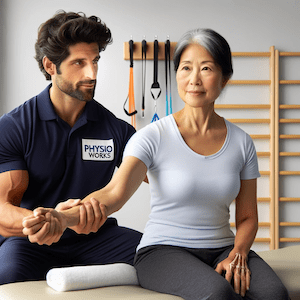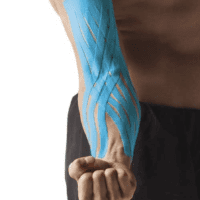Post-Operative Rehabilitation
Article by John Miller

Maximising Recovery: The Importance of Post-Operative Rehabilitation
Why Choose Post-Operative Physiotherapy?
Recovering from surgery extends beyond the operating theatre. As a physiotherapist, I often see patients who underestimate the importance of post-operative rehabilitation.
It’s not just about the surgery itself; it’s about how you recover and regain your strength and functionality afterward. This comprehensive guide will walk you through the benefits and processes of post-operative physiotherapy, highlighting why it’s a crucial step in your recovery journey.
The Role of Physiotherapy in Post-Operative Care
After surgery, your body undergoes a significant recovery process. Physiotherapy plays a pivotal role in ensuring a smooth and effective recovery. It helps in managing pain, reducing swelling, and improving circulation.
Additionally, physiotherapy aims to restore strength, flexibility, and overall functionality. Recent studies have shown that patients engaging in physiotherapy post-surgery experience a quicker and more complete recovery.
Early Stages of Post-Op Rehabilitation
In the initial phase following surgery, physiotherapy focuses on gentle exercises to reduce the risk of complications such as chest infections or deep vein thrombosis (DVT).
Other exercises include strength-building and range of motion activities, tailored to your specific surgical procedure. Regular assessments are crucial during this stage to monitor your progress and adjust your treatment plan as needed.
Advanced Physiotherapy Techniques for Recovery
As you progress, physiotherapy becomes more intensive. Techniques such as manual therapy, therapeutic exercises, and other modalities may be introduced. These are designed to enhance muscle strength, improve joint mobility, and facilitate overall functional recovery.
For example, after orthopaedic surgeries like knee replacements, hip replacement, post-fracture procedures, or shoulder surgeries, specific exercises focusing on the affected area are crucial for regaining mobility and strength.
Customised Post-Operative Physiotherapy Plans
Every surgery and every patient is unique. At PhysioWorks, we develop personalised recovery plans, in collaboration with your surgeon, to ensure that your rehabilitation is aligned with your specific surgical procedure and personal goals.
This bespoke approach ensures that you receive the most effective treatment, whether your goal is to return to work, sports, or daily activities.

Common Surgeries and Post-Operative Physiotherapy
There’s a wide range of surgeries that benefit from post-operative physiotherapy, including but not limited to:
- Shoulder surgeries such as rotator cuff repair and shoulder stabilisation.
- Elbow, wrist, and hand surgeries like tennis elbow release and carpal tunnel release.
- Knee surgeries, including knee replacements, ACL reconstruction, multi-ligament repairs, microfractures and arthroscopy.
- Hip surgeries such as a hip replacement and labral repairs.
- Ankle and foot surgeries such as Achilles tendon repairs, ligament reconstructions and tendon repairs.
- Spinal surgeries like discectomy, laminectomy and spinal fusion.
Latest Research and Developments in Post-Operative Physiotherapy
Recent advancements in physiotherapy have introduced new techniques and modalities that significantly improve post-surgical outcomes. Specific exercise techniques and protocols in particular, are becoming more popular due to their effectiveness in reducing recovery time and improving functional outcomes.
Studies also indicate that early mobilisation post-surgery significantly reduces the risk of complications and shortens hospital stays.
Conclusion
Post-operative physiotherapy is an integral part of your recovery process. It’s not just about healing; it’s about regaining your life and returning to your normal activities. If you’ve undergone surgery, don’t underestimate the power of physiotherapy in your recovery journey.
What to do?
If you’re recovering from surgery, I strongly recommend consulting a professional physiotherapist to discuss your rehabilitation plan. At PhysioWorks, we’re committed to providing comprehensive care and customised recovery plans to meet your specific needs.
Book an appointment with us to take the first step towards a successful post-operative recovery. Remember, your journey to full recovery is just as important as the surgery itself. Let us help you make the most of your post-operative rehabilitation.
Related Articles
- Knee Replacement Surgery Recovery – Readers can learn about the recovery process specific to knee replacement surgeries, including timelines and rehabilitation exercises.
- Rotator Cuff Repair Recovery – This article likely discusses the rehabilitation process after rotator cuff repair surgery, offering insights into exercises and care needed for shoulder recovery.
- Hip Replacement Rehabilitation – Offers detailed guidance on recovering from hip replacement surgery, including early mobilisation strategies and long-term exercise plans.
- ACL Reconstruction Rehabilitation – Provides information on the phases of recovery following ACL reconstruction, with a focus on physiotherapy exercises and milestones.
Common Muscle Injuries
A Physiotherapist's Guide
Introduction
Muscle injuries, presenting as muscle strain, pain or myalgia, are prevalent health issues affecting a wide range of individuals. This detailed guide, from a physiotherapist's perspective, delves into various muscle injuries, elaborating on their management, prevention, and the importance of professional advice. Explore the linked articles for an in-depth understanding of muscle injuries and their effective treatment.
Neck & Back Muscle Injuries: Causes and Solutions
- Back Muscle Pain: This pain often results from prolonged poor posture or physical overuse. Key to relief is engaging in exercises that strengthen the core muscles and improve posture, thereby alleviating the strain on the back.
- Neck Sprain: Caused by sudden, awkward movements, a neck sprain can benefit from a combination of gentle stretches and targeted strengthening exercises to restore flexibility and strength.
- Text Neck: A modern ailment resulting from extended mobile device use, text neck can lead to chronic pain. Regular breaks, posture-awareness, and neck-strengthening exercises are essential for prevention.
- Whiplash: Commonly occurring in car accidents, whiplash requires a careful approach including neck stabilisation exercises and controlled movement to encourage healing and prevent further injury.
Lower Limb Muscle Injuries: Understanding and Treating
- Hamstring Strain: Particularly common among athletes, particularly runners, this strain demands rest initially, followed by a carefully structured rehabilitation program focusing on gradual strength building and flexibility.
- Thigh Strain: Often seen in sports involving sprinting and jumping, thigh strains need a combination of rest, ice, compression, and elevation (RICE) in the initial stages, followed by carefully planned strengthening exercises.
- Groin Strain: This injury requires a nuanced approach, including sufficient rest and targeted exercises, to ensure a safe and effective recovery.
- Calf Muscle Tear: Key to recovery is a balance of rest, gentle stretching exercises, and a gradual return to full activity, ensuring the muscle heals correctly and strength is regained.
Upper Limb Muscle Injuries: Prevention and Care
- Golfer's Elbow and Tennis Elbow: Both these conditions involve inflammation of the tendons and require a rest period, followed by ice therapy and specific exercises tailored to strengthen the affected muscles.
- Corked Thigh: Resulting from direct impacts, these injuries demand immediate application of ice and a controlled, gradual exercise regime for recovery.
- DOMS, Fatigue-Related Cramps & Myalgia: Adequate rest, good hydration, and gentle stretching are crucial in alleviating these conditions.
- RSI: Regular stretching, ergonomic workplace adjustments, and taking breaks are key preventive measures for repetitive strain injury.
Systemic Causes of Muscle Pain: A Holistic View
- Fibromyalgia: This complex condition demands a holistic treatment approach, including exercise routines, stress management techniques, and sometimes medication.
- Rheumatoid Arthritis: Effective management combines medication, gentle exercise, and regular physiotherapy sessions.
Prevention and Management Strategies
- Regular Exercise: Regular physical activity helps maintain muscle strength and flexibility, reducing the risk of muscle injuries.
- Posture Improvement: Good posture, both in motion and at rest, is crucial for preventing muscle strain.
- Proper Warm-up and Cool-down: Adequate warm-up before and cool-down after physical activity is vital in preventing muscle strains and injuries.
- Ergonomic Adjustments: Making ergonomic adjustments at work and during daily activities can significantly reduce the risk of repetitive strain injuries and other muscle-related issues.
- Maintaining a Healthy Weight: Keeping a healthy weight reduces the strain on muscles, particularly in weight-bearing joints.
What to Do? Seeking Professional Advice
Consult a physiotherapist or doctor for personalised advice and treatment plans. Remember, early intervention can significantly improve recovery outcomes and prevent chronic problems.
Conclusion
While muscle injuries are common, effective management and prevention are achievable with the right approach and knowledge. Understanding the causes, symptoms, and various treatments available empowers individuals to take proactive steps in their recovery and prevention. For the most tailored and effective treatment, always seek the guidance of a professional physiotherapist.

















































































